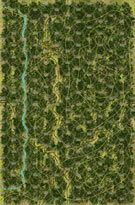| Author |
dricher
|
| Method |
Solo |
| Victor |
Japan |
| Play Date |
2015-01-19 |
| Language |
English |
| Scenario |
KoTr017
|
In this scenario, the Japanese are again trying to take the western and eastern hills, the trail, and inflict more casualties on the Australians than they receive, but at least 14. However, in this one, they must complete all four for a major, three for a minor, two gets the Australians a minor, and only one is a major Australian victory. The Japanese again come in with a significant force on the north edge, but on turn ten get reinforcements on the southern or eastern edges. The Australians get a neat feature for this set, air support. The turn length is forty compared to the previous twenty turn version. Strangely, the Australians are allowed to exit off the southern edge, but as this does nothing to secure a victory condition, and in fact makes victory easier for the Japanese, I’m not sure why one would do so.
The Australians once again guard the hills with small outposts, line the northern edge of the trail as far forward as they are allowed, but also this time leave a small screening force against the base of the eastern hill. The Japanese enter along the trail and the eastern side of the northern edge. The intent is to secure the trail and the eastern hill, with the reinforcements coming in to support the push against the eastern hill. The western hill will only become an objective if time and forces allow.
As with all plans, it fails to survive contact with the enemy. Japanese direct fire is abysmal, and the assaults go in against positions not softened. The Australians start to lead in the inflicted casualty department. The eastern Japanese attack wing begins to head to the central trail. While the Australians pull some forces from the east to assist, they cannot release all units for fear of the hidden movement reinforcements. They also begin to move up some western units towards the trail bend. Combat between the two sides stays about equal for some time, but the Japanese are slowly pushing down the trail.
The reinforcements change their target. With the advance against the eastern hill at a standstill, they move to clip the defenders at the southern tip of the western hill, grabbing trail hexes along the way. The attack is ineffective, but does draw defenders off the north end of the hill to ensure the position does not collapse. The Australians also begin a harder pull from the eastern hill. About this time the Japanese really begin to break the middle. Australian casualties begin to mount, and the north end of the western hill begins to collapse. The Australians have formed a powerful defensive position on the trail side of each hill, and Japanese efforts to crack them are throwing Japanese troops into disarray. Casualties are light, but disruption and demoralization are rampant.
The Japanese finally flank the position on the eastern hill and establish a firing position at the same height level. This becomes the telling moment as the Japanese score a 2X against the position with direct fire, then flood it with an assault. The northern position of the east hill breaks at the same time, and on turn 27 it appears the Australians are in huge trouble. By turn 31 the Australians are reduced to one solid defensive position on the southern tip of the western hill, one platoon falling back to the very eastern hex of the eastern hilltop, and a couple of other units wandering aimlessly as the few long contested assault hexes begin to resolve with demoralized Australian units fleeing. The Japanese clean up the trail and surrounding areas as well as the eastern hill. The last three Australians units on the board, an HMG, an Inf, and a half strength Inf, are left holding the southern tip of the western hill. As hard as the Japanese try, they cannot crack that position, and the game ends with the Australians contesting a single remaining hex on the western hill. Final casualty count is 53 Australian steps, 20 Japanese. A minor Japanese victory.
Rated this one a 3, vice the sister scenario a 5. The game length is very long. While there is a great firefight in the beginning, by turn 30 or so the Australians were mostly just recovering or passing. If the Japanese can break through and get an upper hand on casualties the Australian collapse becomes one of desperation. Unlike the previous scenario the Japanese never felt the time constraint as a form of pressure. Granted, they needed time to meet so many objectives, but once the Japanese dealt with accepting a minor victory, all they needed was to crack one hill, and there was plenty of time for that. Which hill varied during the scenario, but force structure and time were sufficient for the task. It just didn’t hold the same tension as the last scenario once Australian positions cracked on turn 27. Still a good scenario, but even five fewer turns would have substantial impact.
|





 KoTr016
KoTr016 
















